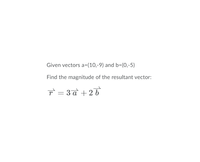
College Physics
11th Edition
ISBN: 9781305952300
Author: Raymond A. Serway, Chris Vuille
Publisher: Cengage Learning
expand_more
expand_more
format_list_bulleted
infoPractice Pack
Question
infoPractice Pack

Transcribed Image Text:Given vectors a=(10,-9) and b=(0,-5)
Find the magnitude of the resultant vector:
T = 3 a +26
Expert Solution
This question has been solved!
Explore an expertly crafted, step-by-step solution for a thorough understanding of key concepts.
Includes step-by-step video
Learn your wayIncludes step-by-step video
Step by stepSolved in 2 steps with 2 images

Knowledge Booster
Learn more about
Need a deep-dive on the concept behind this application? Look no further. Learn more about this topic, physics and related others by exploring similar questions and additional content below.Similar questions
- If vector A has components Ax = -3.0 and Ay = -4.0, and vector B has components Bx = 3.0 and By = -8.0, what is the magnitude of vector C =A −B?arrow_forwardConsider the three displacement vectors A = (4î – 3ĵ) m, B = (9î – 3ĵ) m, and C = (−61 + 5ĵ) m. Use the component method to determine the following. (Take the +x direction to be to the right.) (a) the magnitude and direction of the vector D = A + B + C magnitude m direction P counterclockwise from the +x axis (b) the magnitude and direction of E= -A-B+C magnitude m direction counterclockwise from the +x axisarrow_forwardThe magnitude of A is 5.5. Vector A lies in the second quadrant and forms an angle of 34 degrees with the y-axis. The components, A, and A,, are closest to: O Ą=-3.1, A₂= +4.6 O A₂ = +3.1, A₂ = -4.6 QAx +4.6, Ay = -3.1 O Ą= 4.6, A, - -3.1 O A = 4.6, A, - +3.1arrow_forward
- Given (Ã × B) · Ĉ. (a) Prove that for any three vectors Ā, B, and C, AẢ · (B × C) = (Ả × B) · T (b) Calculate (Á × B) · Ć for vector A with magnitude A = 5.00 and angle 6A = 26.0° (measured from the +x -axis toward the +y -axis), vector B with B = 4.00 and OB 63.0°, and vector C' with magnitude 6.00 and in the +z -direction. Vectors A and B are in the xy -plane.arrow_forwardLet vector a = <5,2,4> and vector b = <-4,2,0>. Find vector 2a+3barrow_forwardVector A can be expressed in (i,j,k) notation as 5.0i - 4.0j, and vector B as -7.0i + 2.0j. Determine the value of 3A + 2B in terms of magnitude and angle. The angle can be specified either as a value between 0 and 360 degrees counter- clockwise with respect to the positive x-axis, or as a value between 0 and 90 degrees in the appropriate Cartesian quadrant. Paragraph I + v ... 96% 75°F lılıarrow_forward
- Two vectors Á and B have precisely equal mag- nitudes. For the magnitude of A + B to be 100 times larger than the magnitude of Á – B, what must be the angle between them?arrow_forwardA sailboat race course consists of four legs, defined by the displacement vectors ABC, and, as the drawing indicates. The magnitudes of the first three vectors are A = 2.70 km, B-5.30 km, and C= 4.40 km. The finish line of the course coincides with the starting line. Using the data in the drawing, find (a) the distance of the fourth leg and (b) the angle. 23.0 (a) Number (b) Number Units Units B Finish- K 35.0 X 40.0⁰ Startarrow_forwardVector A = (8, 4, -5) and Vector B = (-2, 3, 0). Find the angle between these two vectors.arrow_forward
- Two vectors A⃗ and B⃗ are at right angles to each other. The magnitude of A⃗ is 2.00. What should be the length of B⃗ so that the magnitude of their vector sum is 5.00?arrow_forwardImagine that you take the cross product A x B, where A-22 +79 and B=10€ +99. What is the z-component of the resulting vector?arrow_forwardThree vectors A, B, and C have the following components: Ax=5.00, Ay=7.00; Bx=4.00, By=3.00; Cx=2.00, Cy=5.00. (a) Find the x and y components of A+B +C. (b) Find the magnitude and direction of A+B+Carrow_forward
arrow_back_ios
SEE MORE QUESTIONS
arrow_forward_ios
Recommended textbooks for you
 College PhysicsPhysicsISBN:9781305952300Author:Raymond A. Serway, Chris VuillePublisher:Cengage Learning
College PhysicsPhysicsISBN:9781305952300Author:Raymond A. Serway, Chris VuillePublisher:Cengage Learning University Physics (14th Edition)PhysicsISBN:9780133969290Author:Hugh D. Young, Roger A. FreedmanPublisher:PEARSON
University Physics (14th Edition)PhysicsISBN:9780133969290Author:Hugh D. Young, Roger A. FreedmanPublisher:PEARSON Introduction To Quantum MechanicsPhysicsISBN:9781107189638Author:Griffiths, David J., Schroeter, Darrell F.Publisher:Cambridge University Press
Introduction To Quantum MechanicsPhysicsISBN:9781107189638Author:Griffiths, David J., Schroeter, Darrell F.Publisher:Cambridge University Press Physics for Scientists and EngineersPhysicsISBN:9781337553278Author:Raymond A. Serway, John W. JewettPublisher:Cengage Learning
Physics for Scientists and EngineersPhysicsISBN:9781337553278Author:Raymond A. Serway, John W. JewettPublisher:Cengage Learning Lecture- Tutorials for Introductory AstronomyPhysicsISBN:9780321820464Author:Edward E. Prather, Tim P. Slater, Jeff P. Adams, Gina BrissendenPublisher:Addison-Wesley
Lecture- Tutorials for Introductory AstronomyPhysicsISBN:9780321820464Author:Edward E. Prather, Tim P. Slater, Jeff P. Adams, Gina BrissendenPublisher:Addison-Wesley College Physics: A Strategic Approach (4th Editio...PhysicsISBN:9780134609034Author:Randall D. Knight (Professor Emeritus), Brian Jones, Stuart FieldPublisher:PEARSON
College Physics: A Strategic Approach (4th Editio...PhysicsISBN:9780134609034Author:Randall D. Knight (Professor Emeritus), Brian Jones, Stuart FieldPublisher:PEARSON

College Physics
Physics
ISBN:9781305952300
Author:Raymond A. Serway, Chris Vuille
Publisher:Cengage Learning

University Physics (14th Edition)
Physics
ISBN:9780133969290
Author:Hugh D. Young, Roger A. Freedman
Publisher:PEARSON

Introduction To Quantum Mechanics
Physics
ISBN:9781107189638
Author:Griffiths, David J., Schroeter, Darrell F.
Publisher:Cambridge University Press

Physics for Scientists and Engineers
Physics
ISBN:9781337553278
Author:Raymond A. Serway, John W. Jewett
Publisher:Cengage Learning

Lecture- Tutorials for Introductory Astronomy
Physics
ISBN:9780321820464
Author:Edward E. Prather, Tim P. Slater, Jeff P. Adams, Gina Brissenden
Publisher:Addison-Wesley

College Physics: A Strategic Approach (4th Editio...
Physics
ISBN:9780134609034
Author:Randall D. Knight (Professor Emeritus), Brian Jones, Stuart Field
Publisher:PEARSON